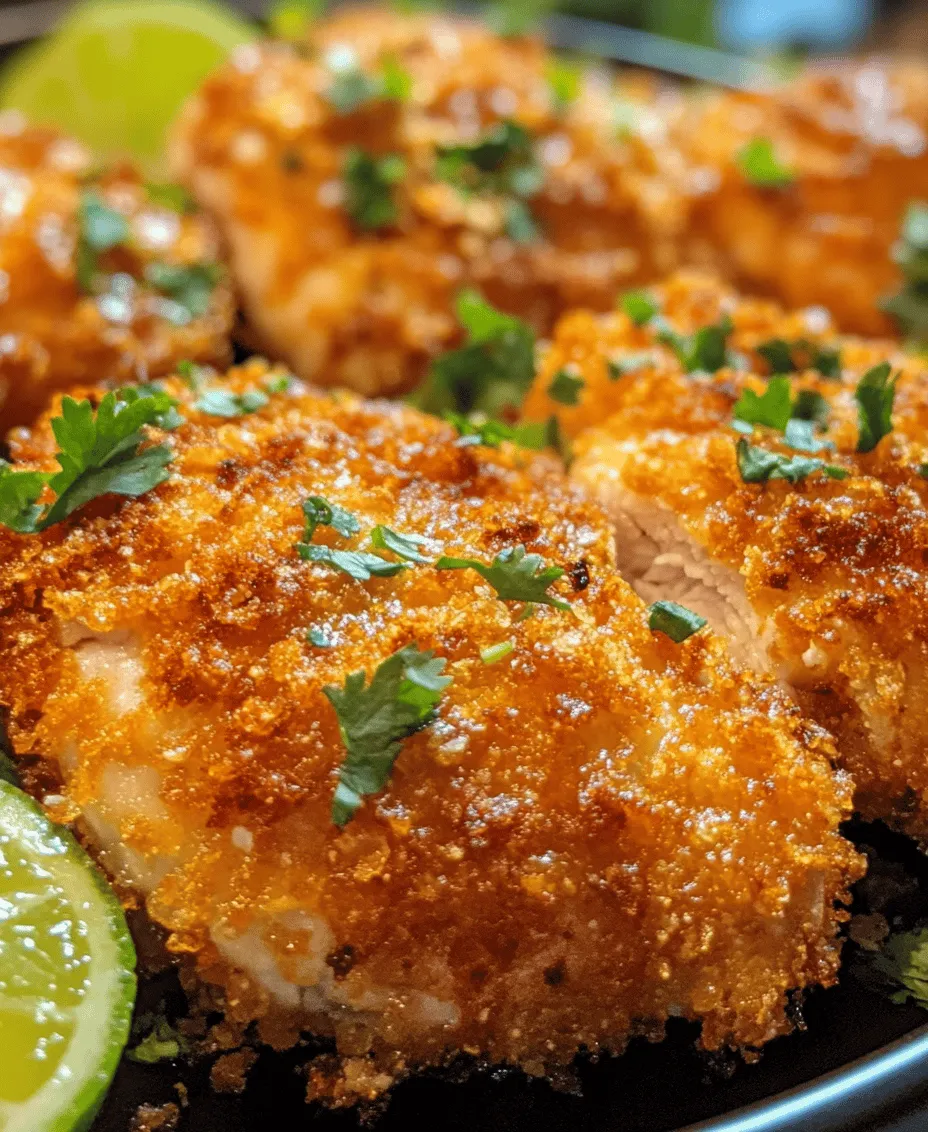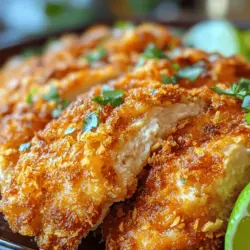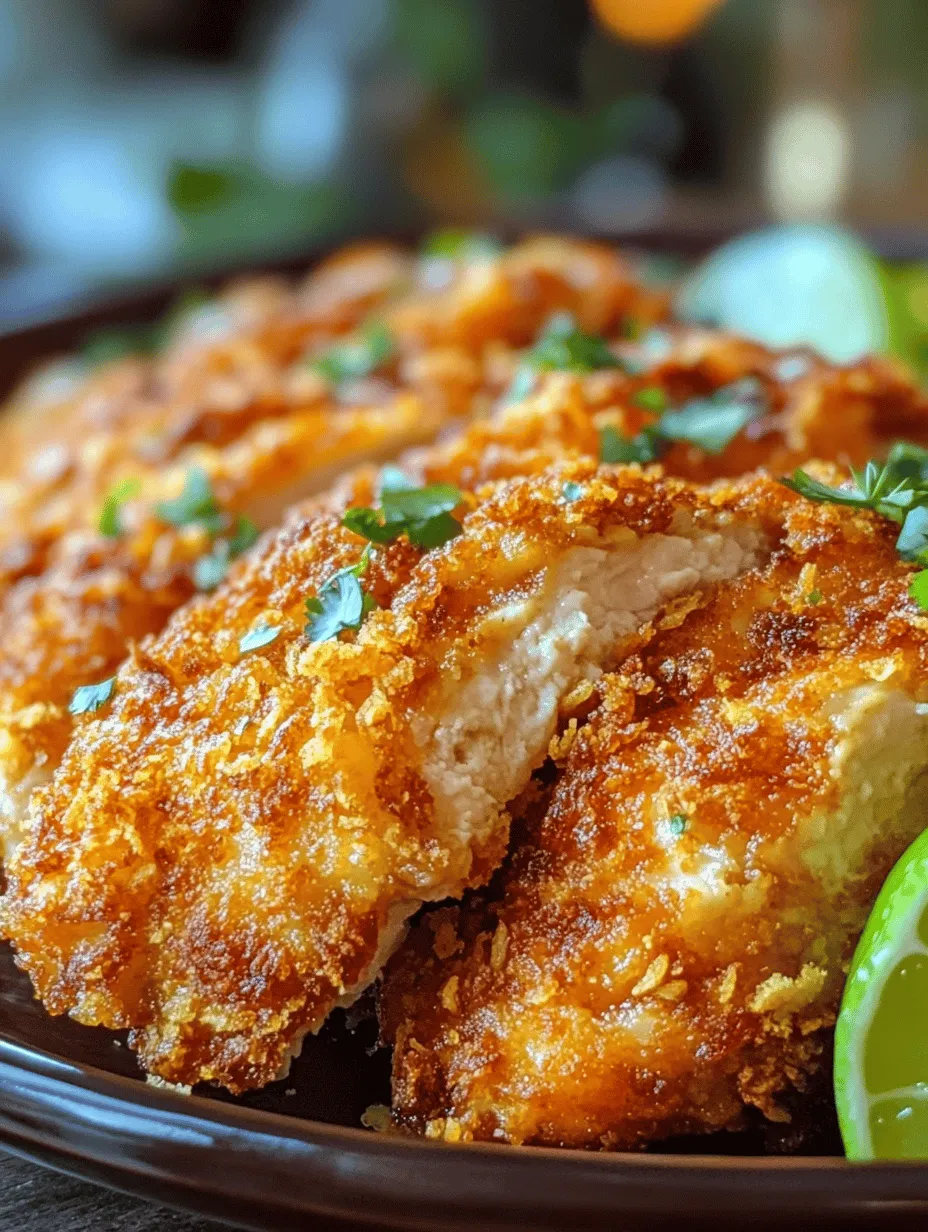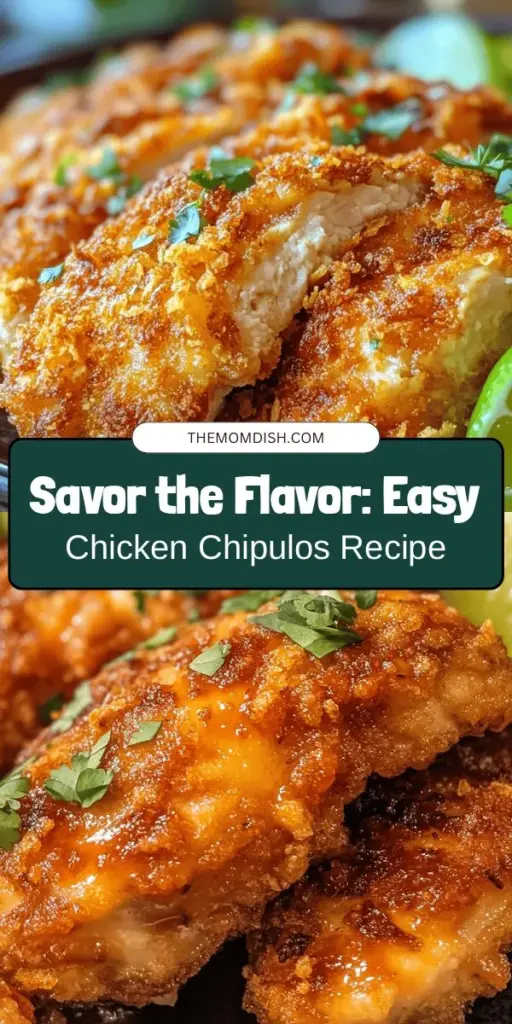Introduction
Chicken Chipulos is a vibrant and tantalizing dish that brings together the rich flavors of Mexican cuisine with a unique twist. Originating from the heart of traditional Mexican fare, this dish is celebrated for its bold profile, combining the smoky heat of chipotle peppers with the tender juiciness of marinated chicken. The resulting dish is not just a meal; it’s an experience that transports your taste buds to a fiesta of flavors. As you delve into this recipe, you will discover how the right techniques and ingredients can elevate a simple chicken preparation into a culinary masterpiece.
The secret to achieving the perfect Chicken Chipulos lies in the marination and frying techniques. Marinating the chicken allows it to absorb the flavors of spices and sauces, ensuring that each bite is packed with deliciousness. Frying, on the other hand, creates a delightful crispness that contrasts beautifully with the tender meat. In this article, you’ll learn step-by-step instructions on how to prepare Chicken Chipulos, including insights into the essential ingredients that contribute to its distinctive taste and texture.
What can you expect from this article? We will take you through the essential ingredients, the marination process, and preparing your coating mixture to achieve the best results. By the end of this guide, you will be equipped with everything you need to impress your family and friends with this mouth-watering dish.
Understanding the Ingredients
To create a truly memorable Chicken Chipulos, it’s essential to understand the role of each ingredient in the recipe. The right combination of flavors and textures is key to capturing the essence of this dish.
Key Ingredients Overview
1. Chicken Thighs: The primary protein in this dish, chicken thighs are often preferred over chicken breasts for their rich flavor and tenderness. Unlike breasts, which can dry out easily, thighs retain moisture during cooking, making them ideal for marination and frying.
2. Buttermilk: This is not just a liquid; it is a powerhouse of flavor and tenderness. The acidity in buttermilk breaks down the proteins in the chicken, resulting in a more tender and juicy final product. Additionally, its tangy flavor complements the spices beautifully.
3. Chipotle in Adobo Sauce: This ingredient is the star of Chicken Chipulos. Chipotles are smoked jalapeño peppers, and when they are canned in adobo sauce, they take on a rich, smoky, and slightly sweet flavor. This sauce not only adds heat but also enhances the overall flavor profile of the dish.
4. Spices: A blend of smoked paprika, garlic powder, and onion powder contributes depth to the flavor. Smoked paprika brings a subtle smokiness that pairs perfectly with the chipotle, while garlic and onion powders add aromatic warmth.
5. Panko Breadcrumbs: These Japanese-style breadcrumbs provide an incredible crunch when fried. Unlike regular breadcrumbs, Panko is made from crustless bread and has a lighter, airier texture, making it perfect for achieving that crispy outer layer.
The Role of Each Ingredient
Understanding the role of each ingredient will help you appreciate how they work in harmony to create the final dish:
– Buttermilk: The marination in buttermilk is crucial as it not only infuses flavor but also enhances the chicken’s juiciness. The marination process allows the spices to penetrate the meat deeply, ensuring that every bite is bursting with flavor.
– Chipotle in Adobo Sauce: This ingredient introduces a complex layer of heat and smokiness. The sweetness from the adobo sauce balances the spice, making the dish flavorful without overwhelming heat.
– Spices: The combination of smoked paprika, garlic powder, and onion powder rounds out the dish, adding layers of flavor that enhance the overall profile. These spices work together to create a cohesive taste that is both robust and comforting.
– Choice of Chicken: Opting for chicken thighs instead of other cuts contributes significantly to the dish’s success. The extra fat in thighs provides richness and helps the meat remain succulent during cooking.
– Panko Breadcrumbs: The use of Panko not only enhances the texture of the dish but also allows for a lighter crunch compared to traditional breadcrumbs. This contrast adds an exciting element to the dish, making it more enjoyable.
Marination Process
Now that you understand the importance of the ingredients, let’s delve into the marination process, which is a pivotal step in creating Chicken Chipulos.
Steps for Marinating Chicken
1. Combine the Ingredients: Start by creating your marinade. In a large bowl, mix together the buttermilk, minced chipotle in adobo sauce, smoked paprika, garlic powder, onion powder, and a pinch of salt. The combination of these ingredients will not only season the chicken but also create a rich, flavorful base.
2. Prepare the Chicken: Trim any excess fat from the chicken thighs and pat them dry with paper towels. This step is essential as it allows the marinade to cling to the meat effectively.
3. Marinate: Place the chicken thighs into the marinade, ensuring they are fully submerged. It’s vital to massage the marinade into the chicken to allow for maximum flavor absorption. Once coated, cover the bowl with plastic wrap or transfer the mixture to a resealable plastic bag.
4. Refrigerate: For best results, let the chicken marinate in the refrigerator for at least 1 hour; however, marinating overnight is recommended for deeper flavor penetration. The longer the chicken sits in the marinade, the more flavorful it will become.
Recommended Marination Time and Tips
– Time: While a minimum of 1 hour is sufficient, marinating overnight allows the flavors to mingle and the chicken to become incredibly tender. Aim for 4 to 8 hours if time permits, as this will yield the best results.
– Temperature: Always marinate chicken in the refrigerator to prevent bacterial growth. Avoid leaving it at room temperature, as this can lead to food safety issues.
– Flavor Absorption: Remember that the marinade should be adjusted according to your heat tolerance. If you prefer a milder flavor, reduce the amount of chipotle used or balance it with additional buttermilk.
The Science Behind Marinating Chicken
Marinating chicken is not just a culinary tradition; it’s backed by science. The acidic components in buttermilk and the spices help break down the protein structures in the meat. This process leads to several benefits:
– Tenderness: As the proteins break down, the chicken becomes more tender and easier to chew.
– Flavor Enhancement: The longer the chicken marinates, the more flavor it absorbs. This results in a juicy piece of meat that is well-seasoned throughout.
– Moisture Retention: Marinating chicken also helps it retain moisture during cooking. Chicken can easily dry out when exposed to high heat, but the buttermilk acts as a barrier, keeping it juicy.
Preparing for Cooking
Once your chicken has marinated to perfection, it’s time to prepare for cooking. The coating mixture is crucial for achieving that coveted crunch on the outside while keeping the inside moist and flavorful.
Step-by-Step Guide to Preparing the Coating Mixture
1. Gather Your Ingredients: For the coating, you will need Panko breadcrumbs, a bit of salt, and additional smoked paprika for flavor enhancement. Some recipes also suggest adding a dash of cayenne pepper for an extra kick.
2. Mix the Coating: In a shallow dish, combine the Panko breadcrumbs with the salt and smoked paprika. If you’re using cayenne pepper, add it at this stage. Stir the mixture until evenly combined.
3. Dredging Process: Remove the marinated chicken from the refrigerator. Allow any excess marinade to drip off before dredging. Dip each piece of chicken into the breadcrumb mixture, pressing down gently to ensure the breadcrumbs adhere well. The goal is to have an even coating that will fry up beautifully.
4. Let it Rest: After coating each piece, place them on a wire rack or a plate. Allowing the chicken to rest for about 10-15 minutes before frying will help the coating stick better and create a crunchier texture when cooked.
By following these steps, you are setting the stage for a delightful Chicken Chipulos that will impress anyone lucky enough to taste it. Stay tuned for the next part of this article, where we will guide you through the frying process and serve up tips for the best results.

Tips for Achieving an Even Coating on the Chicken
Achieving an even coating on the chicken for your Chicken Chipulos is essential for ensuring that each bite is flavorful and crispy. Here are some useful tips to help you master the coating process:
1. Dry the Chicken Thoroughly: Before starting, make sure your chicken thighs are patted dry with paper towels. Excess moisture can prevent the coating from adhering properly and achieving that desired crunch.
2. Use a Two-Step Breading Process: To create a thicker, more even coating, consider using a two-step breading process. First, dredge the chicken in the seasoned flour mixture, ensuring all surfaces are covered. Shake off any excess flour. Then, dip the chicken into an egg wash before coating it with breadcrumbs. This method helps the breadcrumbs adhere better.
3. Press the Coating: After applying the breadcrumbs, gently press them onto the chicken to ensure they stick. This additional pressure helps create a more robust crust that holds up during frying.
4. Allow Coated Chicken to Rest: After coating, let the chicken pieces rest on a wire rack for about 10-15 minutes. This resting period allows the coating to set, which helps it stick better during frying.
5. Avoid Overcrowding: When frying, avoid placing too many chicken pieces in the oil at once. This can cause the temperature to drop, resulting in soggy chicken instead of crispy.
Importance of the Flour and Breadcrumb Mixture in Creating a Crispy Texture
The flour and breadcrumb mixture plays a pivotal role in achieving a crispy texture for Chicken Chipulos. Here’s why each component is important:
– Flour: The flour acts as the initial barrier that helps bind the moisture from the chicken while creating a surface for the breadcrumbs to adhere. Seasoned flour adds flavor and enhances the overall taste of the dish. A blend of all-purpose flour with spices such as paprika, garlic powder, and black pepper can elevate the flavor profile.
– Breadcrumbs: Breadcrumbs provide the crunch factor essential for a satisfying bite. Opt for panko breadcrumbs for an extra crispy texture, as they tend to create larger air pockets during frying. You can also toast regular breadcrumbs beforehand to enhance their flavor and crunch.
Frying Techniques
Frying is an art that, when done correctly, yields beautifully golden and crispy Chicken Chipulos. Below is an overview of the frying methods and equipment needed, along with detailed instructions for frying chicken thighs.
Overview of Frying Methods and Equipment Needed
– Equipment: A heavy-bottomed skillet or deep fryer is ideal for frying Chicken Chipulos. A cast-iron skillet retains heat well, ensuring even cooking. Use a thermometer to monitor the oil temperature accurately.
– Frying Methods: There are two primary frying methods: shallow frying and deep frying. Shallow frying involves using enough oil to cover about half of the chicken pieces, while deep frying fully submerges the food in oil. For Chicken Chipulos, shallow frying is often preferred as it allows for better control over the cooking process.
How to Determine the Right Oil Temperature for Frying
The right oil temperature is critical for achieving the perfect fry. Here’s how to determine it:
1. Use a Thermometer: The ideal frying temperature for Chicken Chipulos ranges between 350°F to 375°F (175°C to 190°C). A cooking thermometer can help keep track of the oil’s temperature.
2. Test with a Breadcrumb: If you don’t have a thermometer, drop a small piece of breadcrumb into the oil. If it sizzles and rises to the surface immediately, the oil is ready. If it browns too quickly or burns, the oil is too hot, and you should reduce the heat.
3. Adjust Heat as Necessary: Maintain a steady temperature throughout the frying process. If the oil gets too cool, the chicken will absorb more oil and lose its crispiness. Conversely, if it’s too hot, the outside will burn before the inside is cooked.
Detailed Instructions for Frying Chicken Thighs
1. Prepare the Oil: Fill your skillet with at least ½ inch of oil and heat it over medium-high heat until the desired temperature is reached.
2. Fry the Chicken: Carefully place the coated chicken thighs in the hot oil, ensuring they do not touch. Fry in batches if necessary to avoid overcrowding.
3. Cook Until Golden: Fry the chicken for about 5-7 minutes on each side, or until they are golden brown and crispy. Use a pair of tongs to flip them halfway through the cooking time.
4. Check for Doneness: To ensure the chicken is cooked through, use an instant-read thermometer to check the internal temperature. It should read at least 165°F (74°C). The exterior should be beautifully golden, and the juices should run clear when pierced.
5. Drain Excess Oil: Once cooked, transfer the fried chicken to a plate lined with paper towels to drain excess oil. This step helps maintain the crunchiness of the coating.
Signs of Proper Cooking
– Color: The chicken should be a rich golden brown, indicating that it has achieved the right level of crispiness.
– Texture: A well-cooked chicken thigh will be firm to the touch and have a crispy exterior.
– Internal Temperature: As mentioned, the chicken should reach an internal temperature of 165°F (74°C) for safety and optimal flavor.
How to Fry in Batches Without Overcrowding the Pan for Optimal Results
Frying in batches is essential for achieving crispy Chicken Chipulos without compromising the cooking temperature:
1. Divide the Chicken: Separate the coated chicken into small batches. Depending on the size of your skillet, aim for 2-3 pieces per batch.
2. Monitor the Temperature: After adding the chicken, keep an eye on the oil temperature. If it drops too low, adjust the heat to bring it back to the ideal frying temperature.
3. Rest and Repeat: Once one batch is done, let the oil return to the proper temperature before adding the next batch. This practice ensures each piece fries evenly and maintains that delightful crunch.
Serving Suggestions
Once you’ve fried your Chicken Chipulos to perfection, it’s time to present it in a way that enhances its appeal.
Presentation Tips for Chicken Chipulos
– Serve on a Rustic Platter: Arrange the crispy chicken thighs on a wooden or ceramic platter for a rustic touch. This presentation adds warmth and charm to your dish.
– Layer with Greens: Place a bed of fresh greens, such as arugula or baby spinach, on the platter before adding the chicken. This not only adds color but also provides a refreshing contrast to the rich flavors of the chicken.
Ideas for Garnishing with Fresh Cilantro and Lime Wedges
– Fresh Cilantro: Scatter freshly chopped cilantro over the chicken just before serving for a burst of color and flavor. The herb complements the spices in the chicken beautifully.
– Lime Wedges: Serve lime wedges on the side. A squeeze of fresh lime juice just before eating brightens the dish and enhances its flavors.
Suggested Side Dishes that Complement the Flavors of Chicken Chipulos
– Seasoned Rice: A side of cilantro-lime rice or seasoned jasmine rice pairs well with Chicken Chipulos, balancing the richness of the chicken with a light and zesty flavor.
– Salads: A refreshing salad with mixed greens, avocado, and a citrus vinaigrette adds a crisp contrast to the fried chicken. Consider adding chopped tomatoes and cucumbers for added freshness.
– Dipping Sauces: Serve with a spicy dipping sauce or aioli for an extra layer of flavor. Chipotle mayo or a tangy yogurt sauce can enhance the chicken’s taste.
Nutritional Information
Understanding the nutritional content of Chicken Chipulos can help you appreciate its place in a balanced diet.
Analysis of the Nutritional Content of Chicken Chipulos
– Calories: A typical serving of Chicken Chipulos (about 150g) contains approximately 300-400 calories, depending on the amount of oil absorbed during frying.
– Proteins: Chicken thighs are an excellent source of protein, providing around 25-30g of protein per serving. Protein is essential for muscle repair and overall health.
– Fats: The fat content can vary based on the frying method and oil used. On average, expect about 15-20g of fat per serving, including healthy unsaturated fats.
– Carbohydrates: The flour and breadcrumbs add a small amount of carbohydrates, typically around 20-25g per serving.
Benefits of Including Chicken in a Balanced Diet
Incorporating chicken into your meals provides several health benefits:
– High Protein Source: Chicken is a complete protein, meaning it contains all nine essential amino acids necessary for bodily functions.
– Vitamins and Minerals: Chicken is rich in B vitamins, particularly niacin and vitamin B6, which are crucial for energy metabolism and brain health.
– Versatile Ingredient: Chicken can be prepared in numerous ways, making it easy to incorporate into a variety of dishes, from salads to stir-fries.
Conclusion
Chicken Chipulos is not only a delightful dish but also a testament to the satisfaction of cooking with fresh ingredients and traditional techniques. The combination of crispy, flavorful chicken with zesty garnishes and complementary sides creates a culinary experience that is sure to impress.
By following the detailed instructions and tips outlined in this recipe, you can recreate this flavorful dish in your own kitchen. Remember that cooking is about experimentation and enjoyment, so don’t hesitate to make this recipe your own.
We encourage you to try Chicken Chipulos for your next meal and explore the joy of homemade cooking. The satisfaction of creating a delicious dish from scratch, paired with the bright flavors of fresh ingredients, will undoubtedly make your dining experience memorable. So gather your loved ones, serve up this flavorful chicken, and enjoy the rewarding taste of a homemade meal.



